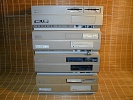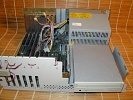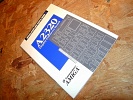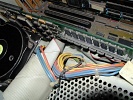Commodore Amiga Retro
C=
Commodore Amiga 2000 Naked
That A2320 Switch
A2320 switch Enabled 31.25 KHzA2320 switch Disabled 15.625 Khz
For monitors that can scan to both frequencies
Information courtesy of Dave Jackson
With very very special thanks to David Jackson
A true Amigan

Data Sheet
Model Range: A1500 A2000 A2000HD A2500/020 A2500/030 A2500UX Released in 1987 as Commodore's first high end expandable machine. Though early models were based around the A1000 design, the later models were built around the A500 chipset. The hard drive version named the A2000HDcame with an A209x SCSI controller and a SCSI hard disk drive. The A2500 version has a processor card added to the A2000HD configuration. The A1500 was aimed primarily at the UK market and was fitted with two floppy drives but no hard disk drive. The A2500UX came with AT&T Unix System V Release 4 operating system instead of AmigaOS, and had a three button mouse, and often with a tape streamer and Ethernet card. Processor 68000 @ 7-28 MHz 68020 @ 7-25 MHz 68030 @ 16-50 MHz 68040 @ 25-40 MHz 68060 @ 50 MHz The A1500 and A2000 have a socketed 68000 @ 7.14 MHz processor on the motherboard and were fitted with an empty processor slot. The A2500 uses a processor card. The A2500/020 came with an A2620 processor card featuring a 68020 and 68881 @ 14 MHz, and the A2500/030 came with an A2630 featuring a 68030 and 68882 @ 25 MHz. Memory up to 2 MB Chip RAM up to 128 MB Fast RAM on processor cards up to 8 MB Fast RAM on Zorro II expansion cards the majority of A2000's have 1 MB RAM soldered to their motherboard. Early models, the 3.x series, have 512 kB Chip RAM on their motherboard and 512 kB Fast RAM on the processor card. The 4.x series have both 512 kB Chip and Fast RAM soldered to the motherboard, whilst the 6.x series have the RAM set up as 1 MB Chip RAM. Chip RAM can be expanded to 2 MB with third party expansions which replace the Agnus chip. 24 bit Fast RAM can be added using Zorro II expansion cards up to 8 MB, and 32 bit Fast RAM using processor cards featuring a 68020 or better. Custom chips Agnus / Fat Agnus - OCS / ECS display controller Denise / Super Denise - OCS / ECS display encoder Paula - audio and I/O controller Gary - system address decoder Buster - DMA arbitrary controller The A2000 OCS or ECS chip set offers the same screen modes as the A500 and A500 Plus: A500 A500+ Low High Low High Super PAL, non-interlaced PAL, interlaced NTSC, non-interlaced NTSC, interlaced 320×256 320×512 320×200 320×400 640×256 640×512 640×200 640×400 320×256 320×512 320×200 320×400 640×256 640×512 640×200 640×400 1280×256 1280×512 1280×200 1280×400 50 Hz, 15.60 kHz 50 Hz, 15.60 kHz 60 Hz, 15.72 kHz 60 Hz, 15.72 kHz Euro36 A2024 320×200 - 1280×400 1024×1024 73 Hz, 15.76 kHz 15 Hz, 15.72 kHz Multiscan Euro72 Super72 640×480 - 640×960 640×400 - 640×800 400×300 - 800×600 60 Hz, 31.44 kHz 70 Hz, 31.43 kHz 72 Hz, 24.62 kHz Using the OCS chip set the A2000 supports either PAL or NTSC screen modes, though not both. Low resolution screen modes offer up to 32 colours from a palette of 4096, 64 in EHB mode or 4096 in HAM mode. High resolution screen modes give 16 colours from 4096, super-high resolution and productivity modes offer 4 colours from a palette of 64. Other screen modes require a Zorro graphics card. The A2000 series has 4 channel stereo 8 bit audio output with frequencies up to 28 kHz using screen modes with 15 kHz, or up to 56 kHz when using screen modes with higher horizontal frequency. 16 bit audio is supported when used on Zorro sound card. A2000s with the OCS chip set shipped with Kickstart 1.2 first, later with 1.3. The ECS models all shipped with 2.04 Kickstart ROM. All versions can be replaced with a 3.1 one. Expansion slots 1× processor card slot (CPU slot) 5× Zorro II slots 1× video slot 2× inactive AT ISA slots 2× inactive XT ISA slots Zorro, ISA and video slots are all fitted to the motherboard. Two AT ISA slots in line with a Zorro II slot, while the XT and video slots are not. The four ISA slots have their power and ground pins activated only. To access the slots with the A2000 a BridgeBoard has to be fitted. With a BridgeBoard installed, two or three ISA compatible cards can be used depending on the BridgeBoard's position - if a bridgeboard is not installed in slot 3 two ISA and four Zorro cards can be used, if it is in slot 4 three ISA and three Zorro cards are possible. Inactive ISA slots can be used for non intelligent cards like TBCs or fan cards. The two XT ISA slots can be upgraded to AT slots by simply soldering the 16 bit extension slots. Early versions of the A2000 have an internal version of the A1000 external edge connector as a processor card slot. All other versions use an 86 pin processor card slot with a coprocessor interface. This allows processor cards to be added without the need to remove the 68000. The A2000 was a very versatile computer with many upgrade options. Drive bays 2× 3.5" front bays 1× 5.25" front bay In the A2000 one, in the A1500 both of the 3.5" bays are occupied with 880 kB double density floppy disk drives. Interfaces 1× serial DB25 male, RS232 1× internal serial 26 pin header 1× parallel DB25 female, Centronics 1× video DB23 male, analog RGB 1× composite, black & white 2× mouse/game DB9 male 2× stereo audio RCA jack 1× keyboard 5 pin DIN female 1× external floppy DB23 female 1× internal floppy 34 pin header The floppy drive controller supports up to four devices. That is two attached to the internal floppy header and two connected to the external floppy port. Both double and high density disk drives are supported. The internal serial header has the same address as the external one. It is intended to be used with internal MIDI interfaces. Motherboard revisions A2000-A: () An integration of the A1000 motherboard design and an example Zorro II backplane. It uses the thin Agnus (DIP) which handles only 512 kB RAM. The video slot is just an internal version of the external video port with the processor card slot as an internal version of the A1000 external edge connector. The A2000-A was a touch unreliable. The Buster chip is missing, as is the composite output connector. Memory is configured as 512 kB Chip RAM on the motherboard and 512 kB Fast RAM in the processor slot. A2000-B: This is a cost reduced version based around the A500 chip set. Most of the control logic for the expansion bus is integrated into the Buster chip. The video slot is extended with more signals and the CPU slot has a coprocessor interface. A black and white composite video connector is provided. 1 MB of RAM is placed on the motherboard. revision 3.9 This was a pre-production A2000-B intended for demonstration purposes which may have problems with processor cards given that there is no additional buffering on the clocks that drive the CPU slot revision 4.0 Offering extra buffering splits Agnus clocks between the expansion and CPU slots rev 4.1 Utilising correction of one missing signal on the video slot No rev 4.0 boards were released because of this bug rev 4.2 Evidently a number of unnecessary filter capacitors were removed to fix the character loss for HITEK type keyboards rev 4.3 A Toshiba manufatured Gary chip is replaced with a CSG (MOS) one, pull-up resistors added to support it rev 4.4 Changes implemented to filtering of a noisy line, cost reduction rev 4.5 () Problems fixed in conjunction with expansion bus DMA turnaround uses Kickstart 1.3 revision 5.0 Motherboard RAM configured to use 256k×4 chips instead of 256k×1 ones revision 6.0 Minor layout and FCC changes rev 6.1 A reset IC added to clean up RAM retention and correction of the noise on the "time of day" clock Uses Agnus 8372 rev 6.2 () Added correction to the noise on the expansion bus caused by a new production of 68000s Fixes to get certain expansion boards to work correctly with 256k×4 DRAMs and Agnus 8372 rev 6.5 Upgrades to use Kickstart 2.04 ROMs and the ECS chip set: Fat Agnus, Super Denise Power supply revised to 220 W power output 2× standard 4 pin power connectors 2× mini 4 pin floppy drive power connectors. There really has never been such a heavily modified and upgraded model of computer. The A2000 was a magic piece of kit.
If you can only see this CONTENT window
then click the image above for the full site
Last updated 07/10/07

























